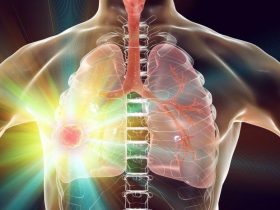Lung cancer is the leading cause of cancer death among both men and women in the United States. Because lung cancer is genetically heterogeneous, tailored therapy alone or in combination with chemotherapy would increase patient overall survival as compared with the one-size-fits-all chemotherapy. TP53-mutant lung cancer accounts for more than half of all lung cancer cases and is oftentimes more aggressive and resistant to chemotherapy. Directly targeting mutant p53 has not yet been successful, so identification of novel therapy targets and biomarkers in the TP53-mutant lung cancer is urgently needed to increase the overall survival in this subgroup. Deubiquitinating enzymes (DUBs) regulate a vast majority of proteins (DUBs’ substrates) via removal of ubiquitin moieties or ubiquitin chains from these proteins, thereby altering the stability and/or functions of these substrates. In this review, we will focus on a DUB, referred to as ubiquitin-specific peptidase 10 (USP10) whose substrates include both oncogenic proteins and tumor suppressors. Therefore, targeting USP10 in cancer is highly context-dependent. Here, we will discuss USP10’s functions in cancer by examining its various known substrates. In particular, we will elaborate our recent findings in the oncogenic role of USP10 in the TP53-mutant subgroup of lung cancer, focusing on USP10’s function in the DNA damage response (DDR) via histone deacetylase 6 (HDAC6). Overall, these findings support the notion that targeting USP10 in the TP53-mutant subgroup of NSCLC would sensitize patients to cisplatin-based chemotherapy. Generating potent and specific clinically relevant USP10 inhibitors would benefit the TP53-mutant subgroup of NSCLC patients.
Implications of the USP10-HDAC6 axis in lung cancer – A path to precision medicine








Leave a Reply